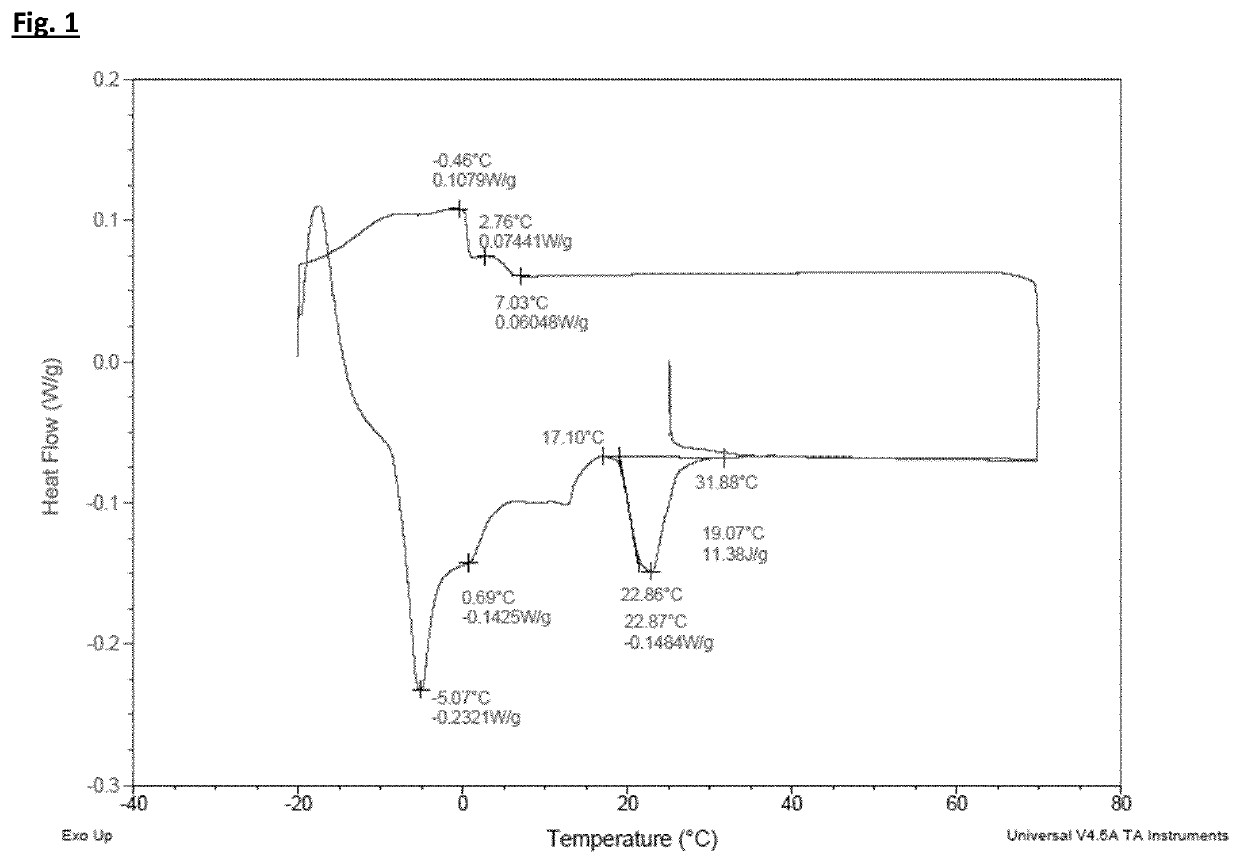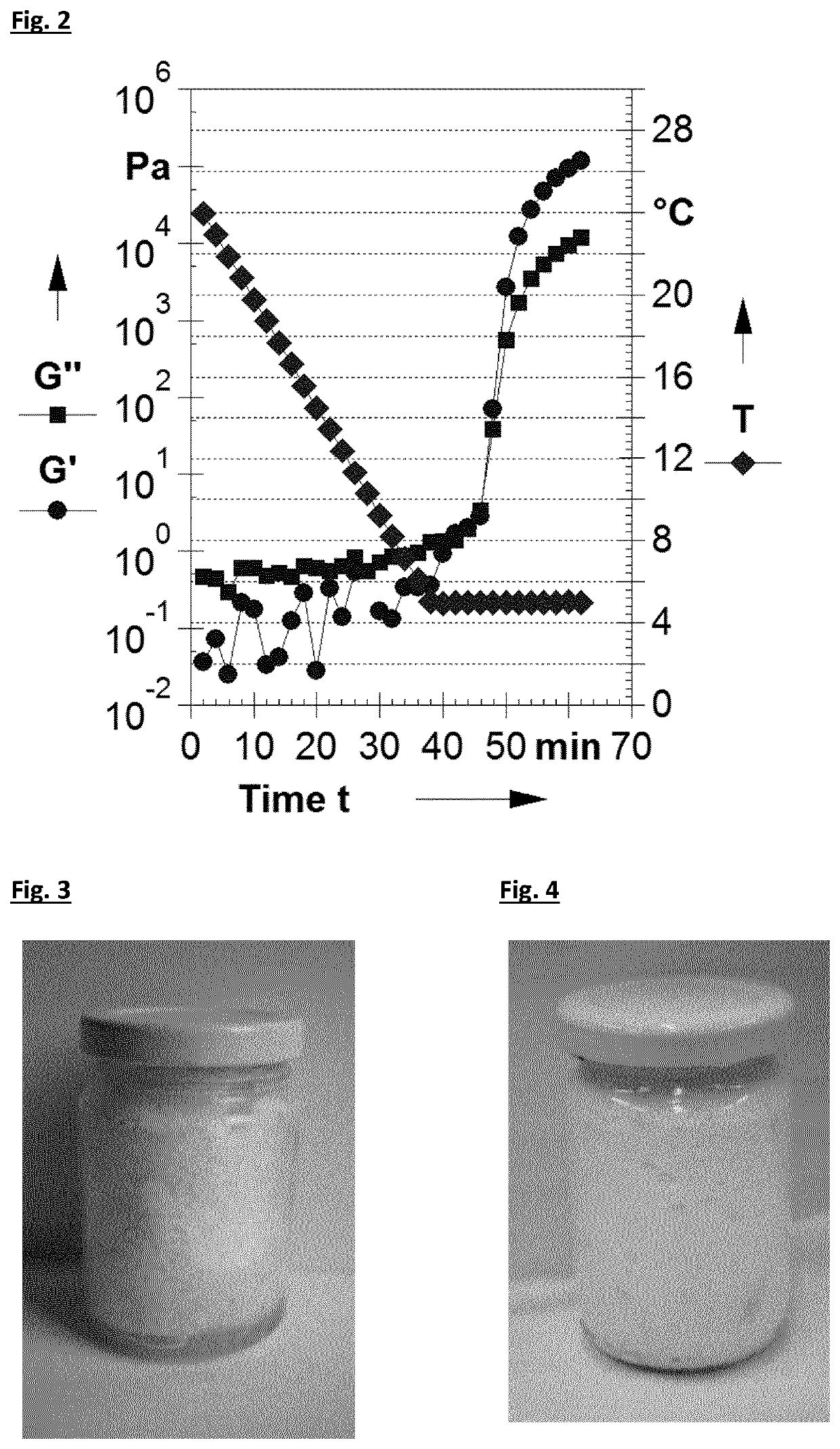Lipid based foam
a foam and lipid technology, applied in the field of foams, can solve the problems of lack of suitable surfactants for forming stable interfaces between air and lipid, lack of suitable surfactants for stabilizing edible foam, and inability to meet the needs of food foam stabilization, etc., to achieve stable crystal-wrapped bubble assemblies, resist bubble shrinkage, and easy destabilization
- Summary
- Abstract
- Description
- Claims
- Application Information
AI Technical Summary
Benefits of technology
Problems solved by technology
Method used
Image
Examples
example 1
Formation of Stable Foams with Cocoa Butter in High Oleic Sunflower Oil
[0073]High Oleic Sunflower Oil (HOSFO) having a melting point of −17° C. (±3)° C. was obtained from (SABO Nestrade). Cocoa butter (Pure Prime Pressed) having a melting point of 35° C. (±3)° C. was obtained from Cargill.
[0074]The melting and crystallizing profile of 20 wt. % cocoa butter in HOSFO was measured by DSC using a SDT Q600 from TA instruments. A sample of around 10-20 mg of cocoa butter in HOSFO was heated to 70° C. before recording the crystallization signature. After cooling to −20° C., it was reheated to 70° C. to record the melting signature. The DSC trace is shown in FIG. 1. It can be seen that the highest melting peak has a peak maximum at about 23° C. and the peak starts at around 17° C. Although different lipids and crystalline forms may have slightly different specific melting enthalpies, the area under the melting peaks in the reheating trace provides a reasonable correlation with the quantity ...
example 2
Foams with Cocoa Butter in High Oleic Sunflower Oil with Addition of Maltodextrin Particles
[0088]Mix preparation: 20 wt. % cocoa butter, 10 wt. % maltodextrin particles (DE11-14) in HOSFO was heated to 70° C. until complete dissolution of the cocoa butter. 250 g of the mix placed in a closed vial. The vial was placed in water, cooled within a double-jacketed container (cooling water at 4° C.) for 20 hours. The gel obtained was stored at 5° C. for 1 week before being placed in a Hobart kitchen mixer at 5° C. fitted with a balloon whisk and whipped at speed 2 for 15 min, 30 min and 45 min. The resulting foam was compared with trial 1.3 above which had the same conditions apart from no maltodextrin particles. The foam with maltodextrin particles has a maximum overrun of 214% (compared to 235% for the sample with no particles). However, the trial with maltodextrin had improved stability against coarsening over time and showed better homogeneity of the foam.
example 3
Foaming of Other Fats at 20 wt. % in High Oleic Sunflower Oil
[0089]A series of other fats were prepared at 20 wt. % in high oleic sunflower oil, being completely melted and then cooled to a gel. The samples were whipped as in example 1.
[0090]
FatConditionsMax overrun & commentsRefined hydrogenatedGel stored at 15° C. for187%coconut oil, Mpt. 38° C.15 h, then at 5° C. for 1 h.Poor storage at 20° C., but(Peerless Foods, Australia)Whipped at 5° C.good at 5° C.Hydrogenated palm kernelGel stored at 15° C. for177%oil, Mpt. 45° C.15 h, then at 5° C. for 2 h.Stable at 20° C. without(Lam Soon, Thailand)Whipped at 5° C.drainage after 7 days butwith some contractionCocoa Butter equivalent,Gel stored at 15° C. for264%Mpt. 45° C. (Loders15 h, then at 5° C. for 20 h.Stable at 20° C. withoutCroklaan)Whipped at 5° C.drainage after 7 daysHigh melting palm fraction,Gel stored at 20° C. for141%Mpt. 60° C. (AAK Sweden)16 h, then at 5° C. for 1 h.Stable at 20° C. withoutWhipped at 5° C.drainage after 7 d...
PUM
| Property | Measurement | Unit |
|---|---|---|
| linear shear elastic modulus G | aaaaa | aaaaa |
| temperature | aaaaa | aaaaa |
| temperature | aaaaa | aaaaa |
Abstract
Description
Claims
Application Information
 Login to View More
Login to View More - R&D
- Intellectual Property
- Life Sciences
- Materials
- Tech Scout
- Unparalleled Data Quality
- Higher Quality Content
- 60% Fewer Hallucinations
Browse by: Latest US Patents, China's latest patents, Technical Efficacy Thesaurus, Application Domain, Technology Topic, Popular Technical Reports.
© 2025 PatSnap. All rights reserved.Legal|Privacy policy|Modern Slavery Act Transparency Statement|Sitemap|About US| Contact US: help@patsnap.com



